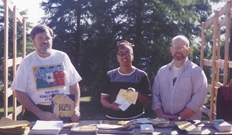

Issue 3 | |||
"Quality housing should be considered a health care issue for children and families." |
Building Healthy Communities As we all know, addressing local needs is far more complicated than it sounds; HUD doesn’t address local needs simply by explaining programs and offering policy guidance to local officials. Rather, HUD must focus on fundamental and complex quality of life issues. Community Builders in Colorado and Maryland are doing just that – proactively moving to improve the health of communities. In Denver, CO, Community Builder Lynn Swanson helped HUD co-sponsor a Forum on Children’s Health and the Environment with the US Environmental Protection Agency (http://www.epa.gov/children) and the Colorado Department of Public Health and the Environment (http://www.cdphe.state.co.us/cdphehom.html). Swanson’s in-depth knowledge of HUD’s role in addressing critical health issues associated with urban conditions helped shape the agenda for the day and frame the ongoing dialogue for the future. The forum addressed the problems associated with environmental pollutants, including lead and pesticide poisoning, which can lead to asthma and other severe health problems for children. The various sessions focused on fostering collaboration among the public, corporate, and nonprofit programs to more effectively target resources and energy spent addressing children’s health issues. For example, one presentation illustrated how children in Denver’s older neighborhoods have elevated lead blood levels compared to children living in non-urban communities or in newer housing. Participants discussed how to work together to have a more immediate and significant impact on addressing this problem. The conference concluded on a positive note – participants are developing a strategic and coordinated action plan to address children’s health needs. "Many forum participants concluded that the lack of public awareness concerning how living environments affect children’s health is a major gap that we must overcome," said Swanson. "It was amazing to hear how some medical practitioners and building owners are reluctant to look at the possibility of paint hazards in homes and apartments. Clearly, lead based paint is still a huge problem that HUD can help address through such forums and ongoing education efforts. This forum was a first step in doing just that." Meanwhile, in Maryland, Community Builder Fellow Carol Payne formed a coalition of partners to expand the reach of HUD’s lead-based paint programs. During the recent Lead Poisoning Prevention Week, Community Builders and Public Trust Officers in HUD’s Maryland State Office worked together with the Maryland Department of the Environment and the Coalition to End Lead Poisoning to create a series of prevention awareness events. A home safety exhibit in Baltimore’s Patterson Park helped draw a crowd of over 300 people to learn more about the dangers of lead-based paint.
Recently, Payne had a unique opportunity to further link her professional role and community interests during Baltimore’s Third Annual Walk for Wellness. Carol chaired the event, which encourages physical activity and preventative care as a means of saving lives. "This year’s walk created an excellent opportunity to link my former role as a health care professional and community activist to my work as a HUD Community Builder," said Payne. Carol and several of her Community Builder colleagues worked to include "As we promote healthy communities, I believe it is imperative that the availability of safe and affordable housing, and access to quality health care services are accepted as human rights," said Payne, reflecting on her efforts. "Quality housing should be considered a health care issue for children and families." | ||

 Payne has extensive experience in the healthcare industry
from her roles as a nurse, a research project director for Johns Hopkins
University, and a clinical administrator at Johns Hopkins Hospital. Among
her many duties, she is currently at work with the Maryland Secretary of
Health and other officials focusing on access to health care as a barrier
to long term employment.
Payne has extensive experience in the healthcare industry
from her roles as a nurse, a research project director for Johns Hopkins
University, and a clinical administrator at Johns Hopkins Hospital. Among
her many duties, she is currently at work with the Maryland Secretary of
Health and other officials focusing on access to health care as a barrier
to long term employment. the HOPE VI community of Pleasant View Gardens
and the Westport/Mt. Winans public housing facilities in the Walk for Wellness
activities. Maryland Community Builders helped arrange transportation for
residents of these communities to attend the event. In addition, a team
of Community Builders surveyed public housing participants about health
habits and operated a booth to provide homeownership, fair housing, and
lead prevention literature to over 3,000 walk participants.
the HOPE VI community of Pleasant View Gardens
and the Westport/Mt. Winans public housing facilities in the Walk for Wellness
activities. Maryland Community Builders helped arrange transportation for
residents of these communities to attend the event. In addition, a team
of Community Builders surveyed public housing participants about health
habits and operated a booth to provide homeownership, fair housing, and
lead prevention literature to over 3,000 walk participants.